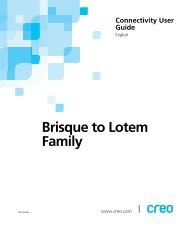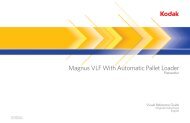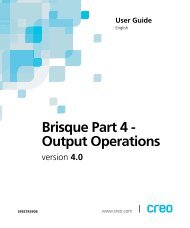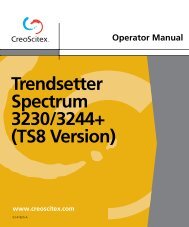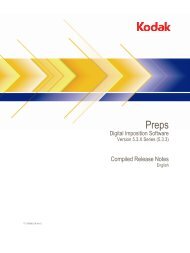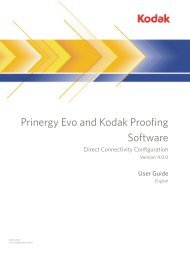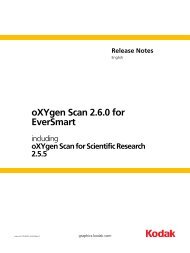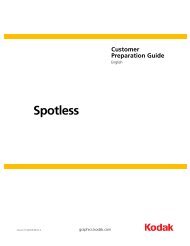oXYgen LE - Kodak
oXYgen LE - Kodak
oXYgen LE - Kodak
- No tags were found...
Create successful ePaper yourself
Turn your PDF publications into a flip-book with our unique Google optimized e-Paper software.
Release NotesEnglish<strong>oXYgen</strong> <strong>LE</strong>Version 2.2.1Internal 739-00323A-EN Rev Agraphics.kodak.com
Copyright© 2006 <strong>Kodak</strong>. All rights reserved.Creo, EverSmart, and <strong>oXYgen</strong> are trademarks of <strong>Kodak</strong>.Adobe, Acrobat, Adobe Illustrator, Distiller, Photoshop, PostScript, and PageMaker are trademarks of Adobe SystemsIncorporated.Apple, iMac, Power Macintosh, Mac OS, AppleShare, AppleTalk, TrueType, ImageWriter, and LaserWriter are registeredtrademarks of Apple Computer, Inc. Macintosh is a trademark of Apple Computer, Inc., registered in the U.S.A. and othercountries.PANTONE, Hexachrome, PANTONE Hexachrome, and PANTONE MATCHING SYSTEM are the property of Pantone, Inc.PEARL, PEARLsetter, PEARLhdp, PEARLdry, and PEARLgold are registered trademarks of Presstek, Inc.XEROX® is a trademark of XEROX CORPORATION.http://graphics.kodak.com/Internal 739-00323A-EN Rev ARevised July 2006
ContentsVersion Highlights........................................................................................................................................... 1Minimum System Requirements...................................................................................................................... 2Software Installation ....................................................................................................................................... 3Starting <strong>oXYgen</strong> <strong>LE</strong> Version 2.2.1 ................................................................................................................... 4Installing the FireWire Driver ........................................................................................................................... 5For Windows XP (SP1) in Languages Other than English ........................................................................... 5For Windows XP (SP2) in Languages Other than English ......................................................................... 13For Windows 2000 in Languages Other than English.............................................................................. 19Running the Install&Utils Program................................................................................................................. 25Registration .................................................................................................................................................. 26Software Folder ............................................................................................................................................ 26Release Documentation ................................................................................................................................ 27Hardware Notes............................................................................................................................................ 27Software Notes............................................................................................................................................. 27Known Issues................................................................................................................................................ 28Appendix A: Appendix 29Setting a Prefix and Suffix ............................................................................................................................. 2916-bit RGB Scanning Mode........................................................................................................................... 30Recommended Workflow ...................................................................................................................... 30Working with DT Files................................................................................................................................... 32Scanning DT Files with <strong>oXYgen</strong> <strong>LE</strong> Software........................................................................................... 32Opening and Editing DT Files ................................................................................................................. 33Creo DT Plug-ins .................................................................................................................................... 33
Version Highlights<strong>Kodak</strong> <strong>oXYgen</strong> <strong>LE</strong> software, version 2.2.1 (CD 501V3R616G) supports iQsmart 1 ,iQsmart 2 , and iQsmart 3 scanners.Version 2.2.1 is released with FireWire boards that comply with the Europeandirective restricting the use of certain hazardous substances in electrical andelectronic equipment (RoHS).For further information about the software, see the <strong>oXYgen</strong> <strong>LE</strong> User Guide.
2 <strong>oXYgen</strong> <strong>LE</strong> Version 2.2.1 Release NotesMinimum System RequirementsiQsmart scanners, with <strong>oXYgen</strong> <strong>LE</strong> software, require the following for properoperation:• Intel Pentium III or IV processor with minimum speed of 860 Mhz• Microsoft Windows 2000 or Windows XP operating system (with Service Pack 1or 2).• CD drive (required for software installation)• 256 MB RAM available for the scanning software• 2 GB internal hard disk recommended• Color monitor of at least 17 inches with a display capability of millions ofcolors• PC Display adaptor: 24-bit color display capability• Image Color Management (ICM) version 2.0 or higher• One free PCI slot for PCI FireWire adaptorNote: The minimum requirements listed in this document are relevant to thisversion of <strong>oXYgen</strong> <strong>LE</strong> only. All later versions are subject to change.
Software InstallationNote: You must have administrator rights to install the <strong>oXYgen</strong> <strong>LE</strong> software or to use theInstall&Utilities software.3Before beginning the installation process, ensure that the scanner is connected tothe computer and turned on.1. Insert the CD into the CD-ROM.2. In the <strong>Kodak</strong> iQsmart Install window that appears, click Install <strong>oXYgen</strong>.A wizard guides you through the installation.3. In the Welcome window, click Next.In the Choose Destination Location window, the default location of thedestination folder appears.4. If you want to install the <strong>oXYgen</strong> <strong>LE</strong> software to the default destination folder,click Next.5. If you want to install the <strong>oXYgen</strong> <strong>LE</strong> software to a folder other than the defaultdestination folder, use the following procedure:a. Click Browse.b. In the Choose Folder window that appears, select a destination folder, andthen click OK.The selected destination folder appears in the Choose DestinationLocation window.c. Click Next.6. In the Digital Signature Not Found window that appears, click ContinueAnyway.The installation begins. A progress bar shows which files are being copied toyour computer and the percentage of the installation that is complete.When the copying of files is complete, the Installation Complete windowappears.7. Click Finish.8. In the <strong>Kodak</strong> iQsmart Install window that appears, click Exit.9. Remove the CD from the CD-ROM drive.10. If you are using an operating system in a language other than English,continue with the procedure Installing the FireWire Driver on page 5.Notes:Before you run the <strong>oXYgen</strong> <strong>LE</strong> software, use the Install&Utils program to create allscanner hardware tables.The first time you run <strong>oXYgen</strong> <strong>LE</strong> software, you are prompted to select the Tables folderin the <strong>oXYgen</strong> folder.
4 <strong>oXYgen</strong> <strong>LE</strong> Version 2.2.1 Release NotesStarting <strong>oXYgen</strong> <strong>LE</strong> Version 2.2.1Before you start the software, you must turn on your computer and scanner asfollows:For Windows XP (SP1):1. Turn on the scanner.2. Turn on the computer.3. Start the software.For Windows 2000 and Windows XP(SP2):1. Turn on the computer2. Turn on the scanner.3. Start the software.
5Installing the FireWire DriverFor Windows XP (SP1) in Languages Other than English1. Make sure the scanner is on and the FireWire cable is connected to the scannerand to PC FireWire port.2. From the Start menu, select Start>Settings>Control Panel>System.3. In the System window, on the Hardware tab, click Device Manager.The name of the <strong>Kodak</strong> scanner driver should appear in the Device Managerwindow. If it does not, continue with the steps in this procedure.4. Insert the <strong>oXYgen</strong> <strong>LE</strong> version 2.2.1 CD into the CD-ROM.5. Select Start>Settings>Control Panel.6. If you are in Category View, you must switch to Classic View.
6 <strong>oXYgen</strong> <strong>LE</strong> Version 2.2.1 Release Notes7. In the Control Panel window, click System.
78. On the Hardware tab, click Device Manager.9. Right-click Unknown device, and from the menu select Update Driver.
8 <strong>oXYgen</strong> <strong>LE</strong> Version 2.2.1 Release Notes10. Select Install from a list or specific location (Advanced), and then click Next.11. Select Don’t search. I will choose the driver to install, and then click Next.
912. Click Have Disk.13. Click Browse.14. Select the path (CD drive)\Drivers\CreoScanner driver.15. In the Locate File window, select CreoScan.inf, and then click Open.
10 <strong>oXYgen</strong> <strong>LE</strong> Version 2.2.1 Release Notes16. In the Install From Disk window, click OK.17. In the Model section, select Creo iQsmart, and then click Next.18. Click Yes.
12 <strong>oXYgen</strong> <strong>LE</strong> Version 2.2.1 Release Notes21. In the Device Manager window, click Imaging devices and make sure thatCreo iQsmart appears.
For Windows XP (SP2) in Languages Other than English1. Make sure the scanner is on and the FireWire cable is connected to the scannerand to PC FireWire port.2. From the Start menu, select Start>Settings>Control Panel>System.3. In the System window, on the Hardware tab, click Device Manager.13The name of the <strong>Kodak</strong> scanner driver should appear in the Device Managerwindow. If it does not, continue with the steps in this procedure.4. In the Device Manager window, In 1394 SCSI Scanner, check for GenericPrinter.5. Right-click Generic Printer, and from the right-click menu select Properties.6. In the Generic Printer window, on the Driver tab, click Update Driver to startthe Upgrade Device Driver Wizard.
14 <strong>oXYgen</strong> <strong>LE</strong> Version 2.2.1 Release Notes7. Select Install from a list or specific location (Advanced), and then click Next.
158. Select Don’t search. I will choose the driver to install, and then click Next.9. Click Have Disk.10. Click Browse.
16 <strong>oXYgen</strong> <strong>LE</strong> Version 2.2.1 Release Notes11. Select the path (CD drive)\Drivers\CreoScanner driver.12. In the Locate File window, select CreoScan.inf, and then click Open.13. Click Yes.
1714. Click Continue Anyway.15. Click Finish.
For Windows 2000 in Languages Other than English1. Make sure the scanner is on and the FireWire cable is connected to the scannerand to PC FireWire port.2. From the Start menu, select Start>Settings>Control Panel>System.3. In the System window, on the Hardware tab, click Device Manager.19The name of the <strong>Kodak</strong> scanner driver should appear in the Device Managerwindow. If it does not, continue with the steps in this procedure.4. In the Device Manager window, in Other devices, check for Unknown device.5. In the Device Manager window, In 1394 SCSI Scanner, check for GenericPrinter.If Other devices or 1394 SCSI Scanner appears, continue with the steps in thisprocedure.6. Right-click Unknown device.7. Select Properties.8. In the Unknown Devices window, on the Driver tab, click Uninstall to removethe selected device.9. Close the Unknown Device window.
20 <strong>oXYgen</strong> <strong>LE</strong> Version 2.2.1 Release Notes10. In the Device Manager window, in 1394 SCSI Scanner, check for GenericPrinter.11. Right-click Generic Printer, and from the right-click menu select Properties.12. In the Generic Printer window, on the Driver tab, click Update Driver to startthe Upgrade Device Driver Wizard.13. Click Next.
2114. Make sure Search for a suitable driver for my device is selected, and then clickNext.15. Select Specify a location, and then click Next.
22 <strong>oXYgen</strong> <strong>LE</strong> Version 2.2.1 Release Notes16. Insert the <strong>oXYgen</strong> <strong>LE</strong> software CD into the CD-ROM drive, and then clickBrowse.17. In the Locate File window, in CD Drive\Drivers\iQsmart driver, select theiQsmart.inf file, and then click Open.
2318. Select Install one of the other drivers, and then click Next.19. From the list, select Creo iQsmart, and then click Next.
24 <strong>oXYgen</strong> <strong>LE</strong> Version 2.2.1 Release Notes20. Click Yes.21. Click Finish.22. In Imaging devices, make sure that the name of the <strong>Kodak</strong> scanner you areusing appears.
25Running the Install&Utils ProgramWhen you install a new scanner and use the Install&Utils program, a mismatchedserial number message appears when you enter the scanner serial number. Toresolve this issue, use the following procedure:1. In the Scanner Serial Number window, enter the scanner serial number, andthen click Confirm.2. Re-enter the scanner serial number, and then click Confirm.3. In the Scanner Parameters window, click No Backup.4. In the Warning window, click OK.The Calibration Slide Loading window appears.5. Continue the installation process according to the instructions in the iQsmartScanners Installation and Maintenance Guide—Mac and PC Platforms.
26 <strong>oXYgen</strong> <strong>LE</strong> Version 2.2.1 Release NotesRegistrationThe first time you run the software, a registration prompt appears. It is highlyrecommended that you register the software. As a registered user, you can accesscurrent product information.To register the software:1. On the software CD, open the Registration Form folder.2. Follow the registration instructions to complete the Registration Form.Note: If you do not register the software, the registration prompt is displayed weeklyuntil you complete the Registration Form. You can also access the Registration Form at:http://graphics.kodak.com/global/product/scanners/professional_scanners/eversmart_select_ii/scanners_registration_form.htmSoftware FolderAfter you install the software, in Start>Programs><strong>oXYgen</strong>, the following itemsappear in the menu:• <strong>oXYgen</strong> <strong>LE</strong>: Software used for scanning with iQsmart 1 , iQsmart 2 , and iQsmart 3scanners• iQsmart Tables: All tables used by the software when scanning with an iQsmartscanner• Uninstall <strong>oXYgen</strong> <strong>LE</strong>• Color Profiles: Color profile library• Install&Utils: User software for installation and setting of parameters requiredfor scanner operation• Log folder: Scanner log folder• Photoshop Plug-Ins: Adobe Photoshop software plug-ins for use with DT files• Release Documents: <strong>oXYgen</strong> <strong>LE</strong> version 2.2.1 Release Notes• Remove application preferences
27Release DocumentationThe <strong>oXYgen</strong> <strong>LE</strong> software CD includes the following documentation:• Feedback Form for iQsmart Users (English)• iQsmart Scanners Installation and Maintenance Guide (English, French,German, Swedish, Spanish, Italian, Dutch) for use with Macintosh andWindows platforms.• <strong>oXYgen</strong> <strong>LE</strong>—Windows User GuideHardware Notes• You must work with the FireWire card supplied in the installation kit• Do not work with multiple devices and FireWire chainsSoftware Notes• The following features are not available in <strong>oXYgen</strong> <strong>LE</strong> version 2.2.1 with theiQsmart3 scanner:Notes:CopyDotDescreenProductive Group Scans (preview only).Parallel workflowFile>Open (with DT files)<strong>oXYgen</strong> <strong>LE</strong> version 2.2.1 is only available in English.To access future software updates, go to the Scanner Software Downloads page of the<strong>Kodak</strong> website, http://graphics.kodak.com/global/product/scanners/professional_scanners/downloads?countryid=global.• The color profiles with names that begin with the symbol @ are new to thisversion.
28 <strong>oXYgen</strong> <strong>LE</strong> Version 2.2.1 Release NotesKnown Issues• If you create a DT file with LOCO compression on a computer using aWindows operating system, you can open that file with a Windows operatingsystem but not with a Macintosh operating system.• If you are using Adobe Photoshop software with the Creo DT plug-in on aMacintosh operating system, and then you open a DT file that was created witha Windows operating system, the Photoshop software crashes.• After you manually adjust cast factors, you must quit and restart the scanningsoftware• After you open the End Points dialog box, in the Display window, you mustclick Show End Points to view the end points on the Preview image• If you save a new color table using an existing color table name, problems mayresult.• <strong>oXYgen</strong> <strong>LE</strong> does not always adopt a new monitor color profile configured inWindows.Workaround:1. Configure the new color profile in Windows.2. From the main menu, go to Setup.3. Click ICC Setup.In the ICC Flow Setup dialog box, check that the name of the monitorprofile is the same as the one that you configured in Windows. If it is thesame, you have finished the procedure. If it is not the same continue thisprocedure.4. Go to Start>Programs><strong>oXYgen</strong>>Color Profiles.5. Right-click the current monitor color profile.6. Click Uninstall.7. Repeat steps 2 to 3 to verify that the monitor and Windows are using thesame color profile. If the profile is still not the same repeat steps 4-7.
AppendixSetting a Prefix and Suffix1. In the Setup menu, select Prefix/Suffix Setup.2. In the Prefix/Suffix Setup dialog box, specify the settings for applying a prefixand suffix to scan file names.a. In Prefix, enter the a prefix that you want to automatically apply to a scanor group of scans.b. To automatically add a suffix to a scan file name, in Suffix, selectAutomatic.The system assigns a default name to the first image file: (Prefix)_x_y,where x is the number assigned to the preview image and y is the numberassigned to a crop of that preview image. The numbering of both previewsand crops continues consequetively. For example, two consequetive scans,each with two crops, would appear numbered in the following way:SCAN_1_1, SCAN_1_2, SCAN_2_1, SCAN_2_2.
30 <strong>oXYgen</strong> <strong>LE</strong> Version 2.2.1 Release Notesc. If you want to manually add a suffix to a scan file name, select Manual andthen enter a starting number for the suffix sequence in the Start numberbox.Note: In Manual mode, only the preview image is assigned a numberin the suffix. No suffix number appears for a crop.d. Click OK.A prefix and suffix is added to the scan file name according to yourspecifications.16-bit RGB Scanning ModeIn the new 16-bit RGB scanning mode, you can manipulate 16-bit image fileswithout significantly affecting color depth or the characteristics of the image. Colortransition is smoother than it is when you use 8-bit files.Recommended Workflow1. In the Setup dialog box, from the Mode list, select Color RGB 16-bit.2. From the Input Profile list, select an input profile for the scanner that you areusing.
Appendix 313. In the Setup dialog box, select other parameters as required.4. Preview the images.5. Use the software tools according to your requirements. The tools availablewhen you are using 16-bit RGB scanning mode, are:• End Points: Allows you to use the same tables for both 16-bit and 8-bit files.• Sharpness: Allows you to use the same tables for both 16-bit and 8-bit files.• Color Correction: You must save changes for them to be implemented inthe image. A new input profile is created that includes the changes.• Input gray levels: This tool enables you to control the gray levels of yourimage.6. Click Scan to save the image.A 16-bit file is created.7. In Adobe Photoshop software, open the image, and then adjust it according toyour requirements.8. If you want to convert the file to CMYK, in Adobe Photoshop software, selectImage>Mode>CYMK Color or Image>Mode>Convert to Profile.9. If you want to convert the file to 8-bit, in Adobe Photoshop software, selectImage>Mode>8 Bit/Channel.10. Save the file.
32 <strong>oXYgen</strong> <strong>LE</strong> Version 2.2.1 Release NotesWorking with DT FilesA DT file is a raw-data, 16-bit file.Scanning DT Files with <strong>oXYgen</strong> <strong>LE</strong> SoftwareNote: Currently, you cannot open or edit DT files using <strong>oXYgen</strong> <strong>LE</strong> software.When you scan a DT file with <strong>oXYgen</strong> <strong>LE</strong> software, a high-resolution image file iscreated according to the settings in the Setup dialog box.Setting ParametersBefore scanning a DT file, in the Setup dialog box, make sure that in Mode list, youselect DT. You can then set Crop, Scale, size, and Resolution parameters. It isrecommended that you embed an appropriate scanner profile. These are the onlysettings you need to make before scanning the file.Tip: To improve productivity, especially for archiving, use the Direct Scanoption.
Appendix 33Opening and Editing DT FilesCreo DT Plug-insWith the <strong>oXYgen</strong> Scan software (on a Macintosh computer), you can performoffline processing of DT files without a scanner. You can open a 16-bit RGB DT fileand edit it with ICC capabilities to produce the 8-bit file(s) you require.The new Creo DT Tone plug-in enables you to manipulate DT files in AdobePhotoshop software and proceed directly to output. Together with the Creo DTplug-in, that enables you to retouch a DT file in Photoshop software and reopen thefile in the <strong>oXYgen</strong> Open software, this provides a complete solution when workingwith DT files.Creo DT Plug-in Workflow1. From the Start menu, select Programs><strong>oXYgen</strong>>Photoshop Plug-Ins.2. In the folder that opens, copy the three files (including the Creo DT plug-in).3. Open the Adobe Photoshop Plug-Ins folder, and then paste the three files intothe File Format folder.4. In the Photoshop software, select File>Open.5. In the Open dialog box, from the Format list, select Creo DT.6. Retouch the file.7. Save the file in Creo DT file format.8. To continue working on the file, open it with <strong>oXYgen</strong> Open software.For more information about viewing and retouching DT files, go tohttp://graphics.kodak.com/global/product/scanners/professional_scanners/smart_tip_DT.htmCreo DT Tone Plug-in Workflow1. From the Start menu, select Programs><strong>oXYgen</strong>>Photoshop Plug-Ins.2. In the folder that opens, copy the three files (including the Creo DT Tone plugin).3. Open the Adobe Photoshop Plug-Ins folder, and then paste the three files intothe File Format folder.4. In the Photoshop software, select File>Open.5. In the Open dialog box, from the Format list, select Creo DT Tone.The file is opened in 16-bit RGB color mode.Note: Sharpness is not applied to the file.6. Modify the file.7. Convert the file to 8-bit RGB or CMYK, as you require.
34 <strong>oXYgen</strong> <strong>LE</strong> Version 2.2.1 Release Notes8. Save the file.Note: A file opened with the Creo DT Tone plug-in cannot be saved as a Creo DT file andthen opened in the <strong>oXYgen</strong> Open software. This may corrupt the file.




